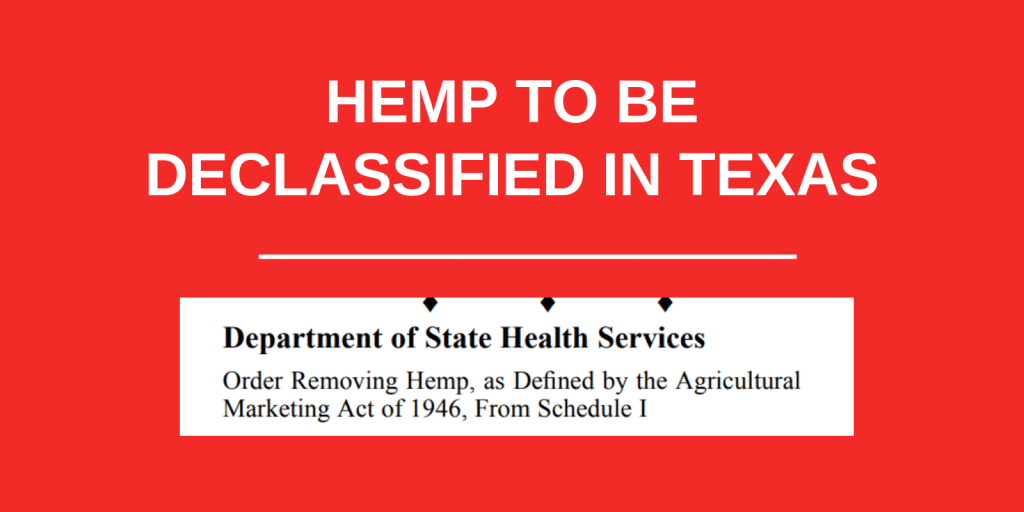Hemp will be descheduled in Texas on April 5, 2019 by the Texas Department of Health Services. If you have been following the blog, then you know that hemp and CBD are both considered illegal substances under current Texas statutory law. However, we have some clarity and action from the Texas Department of State Health Services (“SHS”) in relation to its scheduling of controlled substances. The Department has descheduled hemp in Texas from its list of controlled substances. The Drugs and Medical Devices Division of SHS is responsible for the scheduling of controlled substances for SHS. SHS has the power to amend its scheduling of controlled substances anytime that a change in federal scheduling has occurred. Tex. Health & Safety Code § 481.034 (g) (available here).
Texas SHS has jurisdiction and regulatory power over certain entities, such as drug manufacturers. SHS utilized its authority to add, revise, or delete substances and ordered an amendment that will revise its current definition of “marihuana” and “tetrahydrocannabinol,” as defined under Texas Health and Safety Code § 481.002 and § 481.032 (34), to exclude hemp. This amendment deschedules hemp as a Schedule I substance; though, it does not change the penal code provisions.
The Order was published in the Texas Register of March 15, 2019. After publication, the amendment becomes effective twenty-one days later. Upon the effective date, hemp can no longer be considered a controlled substance in Texas for SHS purposes. The amended definitions of “marijuana” and “tetrahydrocannabinol” are as follows:
Marihuana; The term marihuana does not include hemp, as defined in section 297A(1) of the Agricultural Marketing Act of 1946.
Tetrahydrocannabinols; meaning tetrahydrocannabinols naturally contained in a plant of the genus Cannabis (cannabis plant), except for tetrahydrocannabinols in hemp (as defined under section 297A(1) of the Agricultural Marketing Act of 1946), as well as synthetic equivalents of the substances contained in the cannabis plant…
As a refresher, the 2018 Farm Bill defines “hemp” as “the plant Cannabis sativa L. and any part of that plant, including the seeds thereof and all derivatives, extracts, cannabinoids, isomers, acids, salts, and salts of isomers, whether growing or not, with a delta-9 tetrahydrocannabinol concentration of not more than 0.3 percent on a dry weight basis.” § 297 (a). Thus, as soon as the ordered amendment becomes effective, SHS regulations will permit hemp and hemp-derivative products sourced pursuant to § 297(a) of the 2018 Farm Bill. If the hemp or hemp-derivative product is not sourced pursuant to an approved plan pursuant to § 297(a), it remains a controlled substance.
There may be an argument that a properly sourced, out-of state hemp-derivative good transported into the State of Texas may be used in Texas, pursuant to a Supremacy clause argument and one predicated on the anti-interference with transport clause of the Farm Bill. However, though this argument is being tested in other states, it has not been tested here in Texas as of the date of this blog and we do not know how a Texas court would decide the matter.
Considering that Texas has lagged severely behind other states in regards to its hemp regulations, we are pleased with this development. However, if you want to see the State of Texas pass a bill this session to permit hemp growth as an agricultural commodity and to amend our current penal provisions, please continue to contact your representatives. The current legislative session ends in less than seventy days and our legislature will not reconvene until 2021.
The full text of the Order descheduling hemp issued by Commissioner John Hellerstedt, M.D. can be located in the Texas Register, beginning at page 56: and is also reprinted below.
Department of State Health Services Order Removing Hemp, as Defined by the Agricultural Marketing Act of 1946, From Schedule I The United States Congress enacted the Agriculture Improvement Act of 2018 (Public Law No: 115-334) amending the definitions of marihuana and tetrahydrocannabinols in schedule I of the Controlled Substances Act, effective December 20, 2018. The amendments removed hemp, as defined in 297A of the Agricultural Marketing Act of 1946, from the schedules of controlled substances.
Pursuant to Section 481.034(g), as amended by the 75th legislature, of the Texas Controlled Substances Act, Health and Safety Code, Chapter 481, at least thirty-one days have expired since notice of the above referenced action was taken. In the capacity as Commissioner of the Texas Department of State Health Services, John Hellerstedt, M.D., does hereby order that the listing for marihuana and tetrahydrocannabinols be amended to align with the amendments in P.L. 115-334. –
Schedule I hallucinogenic substances Unless specifically excepted or unless listed in another schedule, a material, compound, mixture, or preparation that contains any quantity of the following hallucinogenic substances or that contains any of the substance’s salts, isomers, and salts of isomers if the existence of the salts, isomers, and salts of isomers is possible within the specific chemical designation (for the purposes of this Schedule I hallucinogenic substances section only, the term “isomer” includes optical, position, and geometric isomers): (1) Alpha-ethyltryptamine (some trade or other names: etryptamine; Monase; alpha-ethyl-1H-indole-3-ethanamine; 3-(2-aminobutyl) indole; alpha-ET; AET); (2) alpha-methyltryptamine (AMT), its isomers, salts, and salts of isomers; (3) 4-bromo-2,5-dimethoxy-amphetamine (some trade or other names: 4-bromo-2,5-dimethoxy-alpha-methylphenethylamine; 4-bromo-2,5-DMA); (4) 4-bromo-2,5-dimethoxyphenethylamine (some trade or other names: Nexus; 2C-B; 2-(4-bromo-2,5-dimethoxyphenyl)-1- aminoethane; alpha-desmethyl-DOB); (5) 2,5-dimethoxyamphetamine (some trade or other names: 2,5-dimethoxy-alpha-methylphenethylamine; 2,5-DMA); (6) 2,5-dimethoxy-4-ethylamphetamine (some trade or other names: DOET); (7) 2,5-dimethoxy-4-(n)-propylthiophenethylamine (2C-T-7), its optical isomers, salts, and salts of isomers; (8) 5-methoxy-N,N-diisopropyltryptamine (5-MeO-DIPT), its isomers, salts, and salts of isomers; (9) 5-methoxy-3,4-methylenedioxy-amphetamine; (10) 4-methoxyamphetamine (some trade or other names: 4-methoxyalpha-methylphenethylamine; paramethoxyamphetamine; PMA); (11) 1-methyl-4-phenyl-1,2,5,6-tetrahydro-pyridine (MPTP); (12) 4-methyl-2,5-dimethoxyamphetamine (some trade and other names: 4-methyl-2,5-dimethoxy-alpha-methylphenethylamine; “DOM”; and “STP”); (13) 3,4-methylenedioxy-amphetamine; (14) 3,4-methylenedioxy-methamphetamine (MDMA, MDM); (15) 3,4-methylenedioxy-N-ethylamphetamine (some trade or other names: N-ethyl-alpha-methyl-3,4(methylenedioxy)phenethylamine; N-ethyl-MDA; MDE; MDEA); (16) 3,4,5-trimethoxy-amphetamine; (17) N-hydroxy-3,4-methylenedioxyamphetamine (Also known as N-hydroxy-MDA); (18) 5-methoxy-N,N-dimethyltryptamine (Some trade or other names: 5-methoxy-3-[2-(dimethylamino)ethyl]indole; 5-MeO-DMT; (19) Bufotenine (some trade and other names: 3-(beta-Dimethylaminoethyl) 5-hydroxyindole; 3-(2 dimethylaminoethyl)-5-indolol; N,N-dimethylserotonin; 5-hydroxy-N,N-dimethyltryptamine; mappine); (20) Diethyltryptamine (some trade and other names: N,N-diethyltryptamine; DET); (21) Dimethyltryptamine (some trade and other names: DMT); (22) Ethylamine Analog of Phencyclidine (some trade or other names: N-ethyl-1-phenylcyclohexylamine; (1-phenylcyclohexyl)-ethylamine; N-(1-phenylcyclohexyl)-ethylamine; cyclohexamine; PCE); (23) Ibogaine (some trade or other names: 7-Ethyl-6,6-beta, 7,8,9,10,12,13-octhydro-2-methoxy-6,9-methano-5H-pyrido [1′,2′:1,2] azepino [5,4-b]-indole; tabernanthe iboga); (24) Lysergic acid diethylamide; *(25) Marihuana; The term marihuana does not include hemp, as defined in section 297A(1) of the Agricultural Marketing Act of 1946. (26) Mescaline; (27) N-ethyl-3-piperidyl benzilate; (28) N-methyl-3-piperidyl benzilate; (29) Parahexyl (some trade or other names: 3-Hexyl-1-hydroxy-7,8,9,10-tetrahydro-6,6,9-trimethyl-6H-dibenzo-[b,d]-pyran; Synhexyl); (30) Peyote, unless unharvested and growing in its natural state, meaning all parts of the plant classified botanically as Lophophora, whether growing or not, the seeds of the plant, an extract from a part of the plant, and every compound, manufacture, salt, derivative, mixture, or preparation of the plant, its seeds, or extracts; (31) Psilocybin; (32) Psilocin; (33) Pyrrolidine analog of phencyclidine (some trade or other names: 1-(1 phenyl-cyclohexyl)-pyrrolidine, PCPy, PHP); *(34) Tetrahydrocannabinols; meaning tetrahydrocannabinols naturally contained in a plant of the genus Cannabis (cannabis plant), except for tetrahydrocannabinols in hemp (as defined under section 297A(1) of the Agricultural Marketing Act of 1946), as well as synthetic equivalents of the substances contained in the cannabis plant, or in the resinous extractives of such plant, and/or synthetic substances, derivatives, and their isomers with similar chemical structure and pharmacological activity to those substances contained in the plant, such as the following: 1 cis or trans tetrahydrocannabinol, and their optical isomers; 6 cis or trans tetrahydrocannabinol, and their optical isomers; 3,4 cis or trans tetrahydrocannabinol, and its optical isomers; (Since nomenclature of these substancesis not internationally standardized, compounds of these structures, regardless of numerical designation of atomic positions covered.); (35) Thiophene analog of phencyclidine (some trade or other names: 1 [1 (2 thienyl)cyclohexyl] piperidine; 2 thienyl analog of phencyclidine; TPCP); (36) 1-[1-(2 thienyl)cyclohexyl]-pyrrolidine (some trade or other names: TCPy); (37) 4-methylmethcathinone (Other names: 4-methyl-N-methylcathinone; mephedrone); (38) 3,4-methylenedioxypyrovalerone (Other names: MDPV); (39) 2-(2,5-Dimethoxy-4-ethylphenyl)ethanamine (Other names: 2C-E); (40) 2-(2,5-Dimethoxy-4-methylphenyl)ethanamine (Other names: 2C-D); (41) 2-(4-Chloro-2,5-dimethoxyphenyl)ethanamine (Other names: 2C-C); (42) 2-(4-Iodo-2,5-dimethoxyphenyl)ethanamine (Other names: 2C-I); (43) 2-[4-(Ethylthio)-2,5-dimethoxyphenyl]ethanamine (Other names: 2C-T-2); (44) 2-[4-(Isopropylthio)-2,5-dimethoxyphenyl]ethanamine (Other names: 2C-T-4); (45) 2-(2,5-Dimethoxyphenyl)ethanamine (Other names:2C-H); (46) 2-(2,5-Dimethoxy-4-nitro-phenyl)ethanamine (Other names: 2C-N); (47) 2-(2,5-Dimethoxy-4-(n)-propylphenyl)ethanamine (Other names: 2C-P); (48) 3,4-Methylenedioxy-N-methylcathinone (Other name: Methylone); (49) (1-pentyl-1H-indol-3-yl)(2,2,3,3-tetramethylcyclopropyl)methanone (Other names: UR-144 and 1-pentyl-3-(2,2,3,3-tetramethylcyclopropoyl)indole); (50) [1-(5-fluoro-pentyl)-1H-indol-3-yl](2,2,3,3-tetramethylcyclopropyl)methanone (Other names: 5-fluoro-UR-144 and 5-F-UR-144 and XLR11 and 1-(5-flouro-pentyl)-3-(2,2,3,3-tetramethylcyclopropoyl)indole); (51) N-(1-adamantyl)-1-pentyl-1H-indazole-3-carboxamide (Other names: APINACA, AKB48); (52) Quinolin-8-yl 1-pentyl-1H-indole-3-carboxylate, its optical, positional, and geometric isomers, salts and salts of isomers (Other names: PB-22; QUPIC); (53) Quinolin-8-yl 1-(5-fluoropentyl)-1H-indole-3-carboxylate, its optical, positional, and geometric isomers, salts and salts of isomers (Other names: 5-fluoro-PB-22; 5F-PB-22); (54) N-(1-amino-3-methyl-1-oxobutan-2-yl)-1-(4-fluorobenzyl)-1H-indazole-3-carboxamide, its optical, positional, and geometric isomers, salts and salts of isomers (Other names: AB-FUBINACA); (55) N-(1-amino-3,3-dimethyl-1-oxobutan-2-yl)-1-pentyl-1H-indazole-3-carboxamide (ADB-PINACA); (56) 2-(4-iodo-2,5-dimethoxyphenyl)-N-(2-methoxybenzyl)ethanamine (25I-NBOMe; 2CI-NBOMe; 25I; Cimbi-5); (57) 2-(4-chloro-2,5-dimethoxyphenyl)-N-(2-methoxybenzyl)ethanamine (25C-NBOMe; 2C-C-NBOMe; 25C; Cimbi-82); (58) 2-(4-bromo-2,5-dimethoxyphenyl)-N-(2-methoxybenzyl)ethanamine (25B-NBOMe; 2C-B-NBOMe; 25B; Cimbi-36); (59) Marihuana Extract Meaning an extract containing one or more cannabinoids that has been derived from any plant of the genus Cannabis, other than the separated resin (whether crude or purified) obtained from the plant. (60) 4-methyl-N-ethylcathinone (4-MEC); (61) 4-methyl-alpha-pyrrolidinopropiophenone (4-MePPP); (62) alpha-pyrrolidinopentiophenone ([alpha]-PVP); (63) 1-(1,3-benzodioxol-5-yl)-2-(methylamino)butan-1-one (butylone, bk-MBDB); (64) 2-(methylamino)-1-phenylpentan-1-one (pentedrone); (65) 1-(1,3-benzodioxol-5-yl)-2-(methylamino)pentan-1-one(pentylone, bk-MBDP); (66) 4-fluoro-N-methylcathinone (4-FMC, flephedrone); (67) 3-fluoro-N-methylcathinone (3-FMC); (68) 1-(naphthalen-2-yl)-2-(pyrrolidin-1-yl)pentan-1-one (naphyrone); (69) alpha-pyrrolidinobutiophenone ([alpha]-PBP); (70) N-(1-amino-3-methyl-1-oxobutan-2-yl)-1-(cyclohexylmethyl)- 1H-indazole-3-carboxamide (Other names: AB-CHMINACA); (71) N-(1-amino-3-methyl-1-oxobutan-2-yl)-1-pentyl-1H-indazole-3-carboxamide (Other names: AB-PINACA); (72) [1-(5-fluoropentyl)-1H-indazol-3-yl](naphthalen-1-yl)methanone (Other names: THJ-2201).
Changes to the schedules are marked with an asterisk (*). TRD-201900723 Barbara L. Klein General Counsel Department of State Health Services Filed: March 1, 2019 ♦
We are pleased to see that Texas has taken its first step towards hemp declassification. Our hemp lawyers are staying up to date on the ongoing changes in Texas law for hemp and cannabidiol. If you own a hemp or medical marijuana business and need representation, please contact Ritter Spencer Cheng PLLC today.





